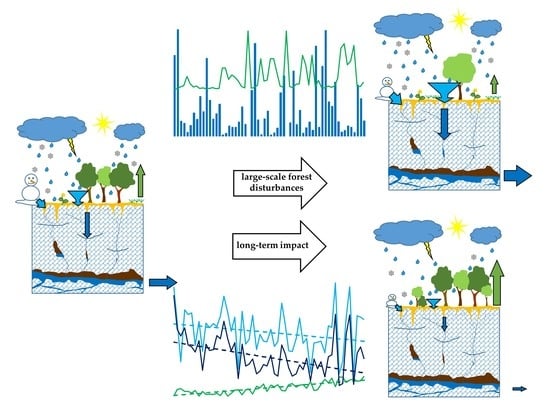Evaluation and Quantification of the Effects of Climate and Vegetation Cover Change on Karst Water Sources: Case Studies of Two Springs in South-Western Slovenia
Abstract
:1. Introduction
2. Materials and Methods
2.1. Study Areas
2.2. Input Data
2.3. Data Processing
2.3.1. Statistical Analysis
2.3.2. Vegetation Cover Changes Analysis
2.3.3. Assessment of the Influence of Changes in Vegetation Cover on the Effective Precipitation
3. Results
3.1. Trend Analysis of the Hydro-Meteorological Parameters
3.2. Evaluation of Changes in Vegetation Cover and Their Influence on Effective Precipitation
4. Discussion
4.1. The Unica Case Study
4.2. The Rižana Case Study
5. Conclusions
Supplementary Materials
Author Contributions
Funding
Acknowledgments
Conflicts of Interest
References
- Ford, D.C.; Williams, P.W. Karst Hydrogeology and Geomorphology; Wiley: Chichester, UK, 2007; ISBN 978-0-470-84996-5. [Google Scholar]
- Stevanovic, Z.; Eftimi, R. Karstic sources of water supply for large consumers in Southeastern Europe–sustainability, disputes and advantages. Geol. Croat. 2010, 63, 179–185. [Google Scholar] [CrossRef]
- Zupan Hajna, N. Encyclopedia of Caves; Academic Press: Amsterdam, The Netherlands, 2012; pp. 195–203. ISBN 9780123838322. [Google Scholar]
- Culver, D.C.; Pipan, T. Subterranean ecosystems. In Encyclopedia of Biodiversity, 2nd ed.; Levin, S.A., Ed.; Academic Press: Waltham, MA, USA, 2013; pp. 49–62. ISBN 978-0-123-84719-5. [Google Scholar]
- Kobal, M.; Bertoncelj, I.; Pirotti, F.; Dakskobler, I.; Kutnar, L. Using Lidar Data to Analyse Sinkhole Characteristics relevant for understory vegetation under forest cover-case study of a high karst area in the Dinaric mountains. PLoS ONE 2015, 10, e122070. [Google Scholar] [CrossRef] [PubMed] [Green Version]
- Bakalowicz, M. Karst groundwater: A challenge for new resources. Hydrogeol. J. 2005, 13, 148–160. [Google Scholar] [CrossRef]
- Moore, C.H. Carbonate Reservoirs Porosity Evolution and Diagenesis in a Sequence Stratigraphic Framework, 1st ed.; Elsevier: Amsterdam, The Netherlands, 2001; ISBN 978-0-444-50838-6. [Google Scholar]
- Smart, C.; Worthington, S.R.H. Groundwater in karst. In Encyclopedia of Caves and Karst Science; Gunn, J., Ed.; Fitzroy Dearborn: New York, NY, USA, 2004; pp. 817–825. ISBN 978-1-57958-399-7. [Google Scholar]
- Jones, W.K.; White, W.B. Karst. In Encyclopedia of Caves; White, W.B., Culver, D.C., Eds.; Academic Press: Amsterdam, The Netherlands, 2012; pp. 430–438. ISBN 9780123838322. [Google Scholar]
- Ford, D. Karst. In Encyclopedia of Caves and Karst Science; Gunn, J., Ed.; Fitzroy Dearborn: New York, NY, USA, 2004; pp. 1017–1020. ISBN 1-57958-399-7. [Google Scholar]
- Worthington, S.R.H. Diagnostic hydrogeologic characteristics of a karst aquifer (Kentucky, USA). Hydrogeol. J. 2009, 17, 1665–1678. [Google Scholar] [CrossRef]
- Murphy, C.; Harrigan, S.; Hall, J.; Wilby, R.L. Climate-driven trends in mean and high flows from a network of reference stations in Ireland. Hydrol. Sci. J. 2013, 58, 755–772. [Google Scholar] [CrossRef]
- Intergovernmental Panel on Climate Change. Climate Change. The Physical Science Basis. Contribution of Working Group I to the Fourth Assessment Report of the Intergovernmental Panel on Climate Change; Cambridge University Press: Cambridge, UK; New York, NY, USA, 2007; 996p. [Google Scholar]
- Luis, M.; Čufar, K.; Saz, M.; Longares, L.; Ceglar, A.; Kajfež-Bogataj, L. Trends in seasonal precipitation and temperature in Slovenia during 1951–2007. Reg. Environ. Chang. 2012, 14, 1801–1810. [Google Scholar] [CrossRef]
- Frei, C.; Schöll, R.; Fukutome, S.; Schmidli, J.; Vidale, P.L. Future change of precipitation extremes in Europe: Intercomparison of scenarios from regional climate models. J. Geophys. Res. Atmos. 2006, 111, 1–22. [Google Scholar] [CrossRef] [Green Version]
- Gobiet, A.; Kotlarski, S.; Beniston, M.; Heinrich, G.; Rajczak, J.; Stoffel, M. 21st century climate change in the European Alps—A review. Sci. Total Environ. 2014, 493, 1138–1151. [Google Scholar] [CrossRef]
- Rodell, M.; Famiglietti, J.S.; Wiese, D.N.; Reager, J.T.; Beaudoing, H.K.; Landerer, F.W.; Lo, M.H. Emerging trends in global freshwater availability. Nature 2018, 557, 651–659. [Google Scholar] [CrossRef] [PubMed]
- Milly, P.C.D.; Dunne, K.A.; Vecchia, A.V. Global pattern of trends in streamflow and water availability in a changing climate. Nature 2005, 438, 347–350. [Google Scholar] [CrossRef]
- Frantar, P.; Hrvatin, M. Discharge regimes in Slovenia from 1971 to 2000. Geogr. Vestn. 2005, 77, 115–127. [Google Scholar]
- Camarasa-Belmonte, A.M.; Segura, F.S. Flood events in Mediterranean ephemeral streams (ramblas) in Valencia region, Spain. Catena 2001, 45, 229–249. [Google Scholar] [CrossRef] [Green Version]
- Stone, D.; Schindel, G.M. The application of GIS in support of land acquisition for the protection of sensitive groundwater recharge properties in the Edwards aquifer of south-central Texas. J. Cave Karst Stud. 2002, 64, 38–44. [Google Scholar]
- Jourde, H.; Roesch, A.; Guinot, V.; Bailly-Comte, V. Dynamics and contribution of karst groundwater to surface flow during mediterranean flood. Environmental Geology 2007, 51, 725–730. [Google Scholar] [CrossRef]
- Hagemann, S.; Chen, C.; Clark, D.; Folwell, S.; Gosling, S.; Haddeland, I.; Haddeland, I.; Hanasaki, N.; Ludwig, F.; Voss, F.; et al. Climate change impact on available water resources obtained using multiple global climate and hydrology models. Earth Syst. Dyn. 2013, 4, 129–144. [Google Scholar] [CrossRef] [Green Version]
- Long, A.J.; Mahler, B.J. Prediction, time variance, and classification of hydraulic response to recharge in two karst aquifers. Hydrol. Earth Syst. Sci. 2013, 17, 281–294. [Google Scholar] [CrossRef] [Green Version]
- Ravbar, N.; Kovačič, G.; Petrič, M.; Kogovšek, J.; Brun, C.; Koželj, A. Climatological trends and anticipated karst spring quantity and quality: Case study of the Slovene Istria. In Advances in Karst Research: Theory, Fieldwork and Applications; Parise, M., Gabrovsek, F., Kaufmann, G., Ravbar, N., Eds.; Geological Society, London, Special Publications: London, UK, 2018; Volume 466, pp. 295–305. [Google Scholar] [CrossRef]
- Loáiciga, H.A.; Maidment, D.R.; Valdes, J.B. Climate-change impacts in a regional karst aquifer, Texas, USA. J. Hydrol. 2000, 227, 173–194. [Google Scholar] [CrossRef]
- Finger, D.; Hugentobler, A.; Huss, M.; Voinesco, A.; Wernli, H.R.; Fischer, D.; Weber, E.; Jeannin, P.-Y.; Kauzlaric, M.C.; Wirz, A.C.; et al. Identification of glacial meltwater runoff in a karstic environment and its implication for present and future water availability. Hydrol. Earth Syst. Sci. 2013, 17, 3261–3277. [Google Scholar] [CrossRef] [Green Version]
- Hartmann, A.; Lange, J.; Aguado, À.V.; Mizyed, N.; Smiatek, G.; Kunstmann, H. A multi-model approach for improved simulations of future water availability at a large Eastern Mediterranean karst spring. J. Hydrol. 2012, 468–469, 130–138. [Google Scholar] [CrossRef]
- Hartmann, A.; Gleeson, T.; Wada, Y.; Wagener, T. Enhanced groundwater recharge rates and altered recharge sensitivity to climate variability through subsurface heterogeneity. Proc. Natl. Acad. Sci. USA 2017, 114, 2842–2847. [Google Scholar] [CrossRef] [PubMed] [Green Version]
- Koohbor, B.; Fahs, M.; Hoteit, H.; Doummar, J.; Younes, A.; Belfort, B. An advanced discrete fracture model for variably saturated flow in fractured porous media. Adv. Water Resour. 2020, 103602. [Google Scholar] [CrossRef]
- Granier, A.; Reichstein, M.; Breda, N.; Janssens, I.A.; Falge, E.; Ciais, P.; Gruenwald, T.; Aubineth, M.; Berbigier, P.; Bernhofer, C.; et al. Evidence for soil water control on carbon and water dynamics in European forests during the extremely dry year: 2003. Agric. For. Meteorol. 2007, 143, 123–145. [Google Scholar] [CrossRef]
- Palahi, M.; Mavsar, R.; Gracia, C.; Birot, Y. Mediterranean forests under focus. Int. For. Rev. 2008, 10, 676–688. [Google Scholar] [CrossRef]
- Bertini, G.; Amoriello, T.; Fabbio, G.; Piovosi, M. Forest growth and climate change: Evidences from the ICP-Forests intensive monitoring in Italy. iForest-Biogeosci. For. 2011, 4, 262–267. [Google Scholar] [CrossRef] [Green Version]
- Bredemeier, M. Forest, climate and water issues in Europe. Ecohydrology 2011, 4, 159–167. [Google Scholar] [CrossRef]
- Kutnar, L.; Kobler, A. Prediction of forest vegetation shift due to different climate-change scenarios in Slovenia. Šumarski List 2011, 135, 113–126. [Google Scholar]
- Michelot, A.; Bréda, N.; Damesin, C.; Dufrêne, E. Differing growth responses to climatic variations and soil water deficits of Fagus sylvatica, Quercus petraea and Pinus sylvestris in a temperate forest. For. Ecol. Manag. 2012, 265, 161–171. [Google Scholar] [CrossRef]
- Dirnböck, T.; Grabherr, G. GIS assessment of vegetation and hydrological change in a high mountain catchment of the Northern Limestone Alps. Mt. Res. Dev. 2000, 20, 172–179. [Google Scholar] [CrossRef]
- Dasgupta, S.; Mohanty, B.P.; Köhne, J.M. Impacts of juniper vegetation and karst geology on subsurface flow processes in the Edwards Plateau, Texas. Vadose Zone J. 2006, 5, 1076–1085. [Google Scholar] [CrossRef] [Green Version]
- Zhang, Z.; Chen, X.; Ghadouani, A.; Shi, P. Modelling hydrological processes influenced by soil, rock and vegetation in a small karst basin of southwest China. Hydrol. Process. 2011, 25, 2456–2470. [Google Scholar] [CrossRef]
- Sarrazin, F.; Hartmann, A.; Pianosi, F.; Rosolem, R.; Wagener, T. V2Karst V1. 1: A parsimonious large-scale integrated vegetation–recharge model to simulate the impact of climate and land cover change in karst regions. Geosci. Model Dev. 2018, 11, 4933–4964. [Google Scholar] [CrossRef] [Green Version]
- Cognard-Plancq, A.L.; Marc, V.; Didon-Lescot, J.F.; Norman, M. The role of forest cover on streamflow down sub-Mediterranean mountain watersheds: A modelling approach. J. Hydrol. 2001, 254, 229–243. [Google Scholar] [CrossRef]
- Theurillat, J.P.; Guisan, A. Potential impact of climate change on vegetation in the European Alps: A review. Clim. Chang. 2001, 50, 77–109. [Google Scholar] [CrossRef]
- Rothe, A.; Huber, C.; Kreutzer, K.; Weis, W. Deposition and soil leaching in stands of Norway spruce and European Beech: Results from the Höglwald research in comparison with other European case studies. Plant Soil 2002, 240, 33–45. [Google Scholar] [CrossRef]
- Pronk, M.; Goldscheider, N.; Zopfi, J. Dynamics and interaction of organic carbon, turbidity and bacteria in a karst aquifer system. Hydrogeol. J. 2005, 14, 473–484. [Google Scholar] [CrossRef] [Green Version]
- Bréda, N.; Huc, R.; Dreyer, E.; Granier, A. Temperate forest trees and stands under severe drought: A review of ecophysiological responses, adaptation processes and long-term consequences. Ann. For. Sci. 2006, 63, 625–644. [Google Scholar] [CrossRef] [Green Version]
- Bonan, G.B. Forests and climate change: Forcings, feedbacks, and the climate benefits of forests. Science 2008, 320, 1444–1449. [Google Scholar] [CrossRef] [Green Version]
- Hartmann, A.; Kobler, J.; Kralik, M.; Dirnböck, T.; Humer, F.; Weiler, M. Model-aided quantification of dissolved carbon and nitrogen release after windthrow disturbance in an Austrian karst system. Biogeosciences 2016, 13, 159–174. [Google Scholar] [CrossRef] [Green Version]
- Hartmann, A.; Baker, A. Modelling karst vadose zone hydrology and its relevance for paleoclimate reconstruction. Earth-Sci. Rev. 2017, 172, 178–192. [Google Scholar] [CrossRef]
- Poljanšek, S.; Vilhar, U.; Levanič, T. Green water reconstructed for Rižana watershed, SW Slovenia. Environ. Earth Sci. 2018, 77, 1–10. [Google Scholar] [CrossRef] [Green Version]
- Kaligarič, M.; Ivajnšič, D. Vanishing landscape of the “classic” Karst: Changed landscape identity and projections for the future. Landsc. Urban Plan. 2014, 132, 148–158. [Google Scholar] [CrossRef]
- Hanewinkel, M.; Cullmann, D.A.; Schelhaas, M.J.; Nabuurs, G.J.; Zimmermann, N.E. Climate change may cause severe loss in the economic value of European forest land. Nat. Clim. Chang. 2013, 3, 203–207. [Google Scholar] [CrossRef]
- Seidl, R.; Schelhaas, M.J.; Lexer, M.J. Unraveling the drivers of intensifying forest disturbance regimes in Europe. Glob. Chang. Biol. 2011, 17, 2842–2852. [Google Scholar] [CrossRef]
- Peng, T.; Wang, S.J. Effects of land use, land cover and rainfall regimes on the surface runoff and soil loss on karst slopes in southwest China. Catena 2012, 90, 53–62. [Google Scholar] [CrossRef]
- Liu, Y.; Huang, X.; Yang, H.; Zhong, T. Environmental effects of land-use/cover change caused by urbanization and policies in Southwest China Karst area–A case study of Guiyang. Habitat Int. 2014, 44, 339–348. [Google Scholar] [CrossRef]
- Gospodarič, R.; Habič, P. Underground Water Tracing: Investigations in Slovenia 1972–1975; Inštitut Za raziskovanje Krasa ZRC SAZU: Postojna, Slovenia, 1976. [Google Scholar]
- Gabrovšek, F.; Kogovšek, J.; Kovačič, G.; Petrič, M.; Ravbar, N.; Turk, J. Recent results of tracer tests in the catchment of the Unica River (SW Slovenia). Acta Carsologica 2010, 39, 27–37. [Google Scholar] [CrossRef]
- Kovačič, G. Hydrogeological study of the Malenščica karst spring (SW Slovenia) by means of a time series analysis. Acta Carsologica 2010, 39, 201–215. [Google Scholar] [CrossRef] [Green Version]
- Petrič, M. Case Study: Characterization, exploitation, and protection of the Malenščica karst spring, Slovenia. In Groundwater Hydrology of Springs; Kresic, N., Stevanovic, Z., Eds.; Butterworth-Heinemann: Oxford, UK, 2010; pp. 428–441. [Google Scholar] [CrossRef]
- Slovenian Environment Agency. Archive of Hydrological Data. Available online: http://vode.arso.gov.si/hidarhiv/ (accessed on 15 December 2019).
- Slovenian Environment Agency. Archive of Meteorological Data. Available online: http://www.meteo.si (accessed on 1 April 2020).
- Krivic, P.; Bricelj, M.; Trišič, N.; Zupan, M. Water tracing experiment in the Rižana spring ground water basin (in Slovene). Acta Carsologica 1987, 16, 83–104. [Google Scholar]
- Krivic, P.; Bricelj, M.; Zupan, M. Underground water connections in Cicarija region and in Middle Istria. Acta Carsologica 1989, 18, 265–295. [Google Scholar]
- Allen, R.G.; Pereira, L.S.; Raes, D.; Smith, M. Crop Evapotranspiration–Guidelines for Computing Crop Water Requirements; FAO Irrigation and Drainage Paper 56; Food and Agriculture Organization of the United Nations: Rome, Italy, 1998; ISBN 92-5-104219-5. [Google Scholar]
- Ministry of Agriculture, Forestry and Food, Records of Actual Use of Agricultural and Forest Land. Available online: https://rkg.gov.si/vstop/ (accessed on 19 December 2019).
- Ministry of Agriculture, Forestry and Food, Pedological Map. Available online: https://rkg.gov.si/vstop/ (accessed on 16 April 2020).
- Mann, H.B. Non-parametric tests against trend. Econometrica 1945, 33, 245–259. [Google Scholar] [CrossRef]
- Kendall, M.G.; Gibbons, J.D. Rank Correlation Methods, 4th ed.; Edward Arnold: London, UK, 1990; ISBN 978-0-85264-305-5. [Google Scholar]
- Hess, A.; Lyer, H.; Malm, W. Linear trend analysis: A comparison of methods. Atmos. Environ. 2001, 35, 5211–5222. [Google Scholar] [CrossRef]
- Theil, H. A rank-invariant method of linear and polynomial regression analysis, Part 1. Proc. R. Neth. Acad. Sci. 1950, 53, 386–392. [Google Scholar]
- Sen, P.K. Estimates of the regression coefficient based on Kendall’s tau. J. Am. Stat. Assoc. 1968, 63, 1379–1389. [Google Scholar] [CrossRef]
- Salmi, T.; Määttä, A.; Anttila, P.; Ruoho-Airola, T.; Ammell, T. Detecting Trends of Annual Values of Atmospheric Pollutants by the Mann-Kendall Test and Sen’s Slope Estimates–the Excel Template Application MAKESENS; Finnish Meteorological Institute, Air Quality Research: Helsinki, Finland, 2002; ISBN 951-697-563-1. [Google Scholar]
- Tilgenkamp, A. Theil-Sen Estimator. Available online: http:/www.mathworks.com/matlabcentral/fileexchange/34308-theil-sen-estimator (accessed on 12 December 2019).
- Helsel, D.R.; Hirsch, R.M. Statistical Methods in Water Resources; Elsevier: New York, NY, USA, 1992; ISBN 978-0-444-88528-9. [Google Scholar]
- Zhao, G.; Hörmann, G.; Fohrer, N.; Zhang, Z.; Zhai, J. Streamflow Trends and Climate Variability Impacts in Poyang Lake Basin, China. Water Resour. Manag. 2010, 24, 689–706. [Google Scholar] [CrossRef]
- Dinpashoh, Y.; Jhajharia, D.; Fakheri-Fard, A.; Singh, V.P.; Kahya, E. Trends in reference crop evapotranspiration over Iran. J. Hydrol. 2011, 399, 422–433. [Google Scholar] [CrossRef]
- Espadafor, M.; Lorite, I.J.; Gavilán, P.; Berengena, J. An analysis of the tendency of reference evapotranspiration estimates and other climate variables during the last 45 years in Southern Spain. Agric. Water Manag. 2011, 98, 1045–1061. [Google Scholar] [CrossRef]
- Tabari, H.; Talaee, P.H. Temporal variability of precipitation over Iran: 1966–2005. J. Hydrol. 2011, 396, 313–320. [Google Scholar] [CrossRef]
- Tabari, H.; Marofi, S.; Aeini, A.; Talaee, P.H.; Mohammadi, L. Trend analysis of reference evapotranspiration in the western half of Iran. Agric. For. Meteorol. 2011, 151, 128–136. [Google Scholar] [CrossRef]
- Some’e, B.S.; Ezani, A.; Tabari, H. Spatiotemporal trends and change point of precipitation in Iran. Atmos. Res. 2012, 113, 1–12. [Google Scholar] [CrossRef]
- Tabari, H.; Talaee, P.H.; Ezani, A.; Some’e, B.S. Shift changes and monotonic trends in autocorrelated temperature series over Iran. Theor. Appl. Climatol. 2012, 109, 95–108. [Google Scholar] [CrossRef]
- Gudmundsson, L.; Seneviratne, S.I. European drought trends. Proc. IAHS 2015, 369, 75–79. [Google Scholar] [CrossRef] [Green Version]
- Yürekli, K. Impact of climate variability on precipitation in the Upper Euphrates–Tigris Rivers Basin of Southeast Turkey. Atmos. Res. 2015, 154, 25–38. [Google Scholar] [CrossRef]
- Kovačič, G. Discharge trends of the Adriatic Sea basin rivers in Slovenia, excluding the Soča river basin. Geogr. Vestn. 2016, 88, 9–29. [Google Scholar]
- Kovačič, G.; Kolega, N.; Brečko Grubar, V. Climate change impacts on water quantities and sea flooding in Slovene Istria. Geogr. Vestn. 2016, 88, 21–36. [Google Scholar]
- Hartmann, A.; Gleeson, T.; Rosolem, R.; Pianosi, F.; Wada, Y.; Wagener, T. A large-scale simulation model to assess karstic groundwater recharge over Europe and the Mediterranean. Geosci. Model. Dev. 2015, 8, 1729–1746. [Google Scholar] [CrossRef] [Green Version]
- Bittner, D.; Narany, T.S.; Kohl, B.; Disse, M.; Chiogna, G. Modeling the hydrological impact of land use change in a dolomite-dominated karst system. J. Hydrol. 2018, 567, 267–279. [Google Scholar] [CrossRef]
- Bittner, D.; Rychlik, A.; Klöffel, T.; Leuteritz, A.; Disse, M.; Chiogna, G. A GIS-based model for simulating the hydrological effects of land use changes on karst systems–The integration of the LuKARS model into FREEWAT. Environ. Model. Softw. 2020, 104682. [Google Scholar] [CrossRef]
- Petrič, M. The role of accurate recharge estimation in the hydrodynamic analysis of karst aquifers. Acta Carsologica 2001, 30, 69–84. [Google Scholar]
- Petrič, M. Characteristics of Recharge-Discharge Relations in Karst Aquifer; ZRC Publishing: Postojna-Ljubljana, Slovenia, 2002. [Google Scholar]
- Sevruk, B. Methods of Correction for Systematic Error in Point Precipitation Measurement for Operational Use; No. 589, Operational Hydrology, Report No. 21; WMO: Geneva, Switzerland, 1982; pp. 1–91. [Google Scholar]
- Dingman, L.S. Physical Hydrology; Macmillan Publishing Company: New York, NY, USA, 1994. [Google Scholar]
- Rutter, A.J.; Kershaw, K.A.; Robins, P.C.; Morton, A.J. A predictive model of rainfall interception on forests. I. Derivation of the model from observations in a plantation of Corsican pine. Agric. Meteorol. 1971, 9, 367–384. [Google Scholar] [CrossRef]
- US Army Corps of Engineers. Runoff from Snowmelt, EM 1110-2-1406; Engineering and Design Manuals; US Army Corps of Engineers: Washington, DC, USA, 1960.
- Shaw, E.M. Hydrology in Practice; Chapman & Hall: London, UK, 1994. [Google Scholar]
- Middelkoop, H.; Daamen, K.; Gellens, D.; Grabs, W.; Kwadijk, J.C.J.; Lang, H.; Parmet, B.W.A.H.; Schädler, B.; Schulla, J.; Wilke, K. Impact of Climate Change on Hydrological Regimes and Water Resources Management in the Rhine Basin. Clim. Chang. 2001, 49, 105–128. [Google Scholar] [CrossRef]
- Horton, P.; Schaefli, B.; Mezghani, A.; Hingray, B.; Musy, A. Assessment of climate-change impacts on alpine discharge regimes with climate model uncertainty. Hydrol. Process. 2006, 20, 2091–2109. [Google Scholar] [CrossRef]
- Bormann, H. Runoff regime changes in German rivers due to climate change. Erdkunde 2010, 64, 257–279. [Google Scholar] [CrossRef]
- Sanmiguel-Vallelado, A.; Morán-Tejeda, E.; Alonso-Gonzalez, E.; López-Moreno, J.I. Effect of snow on mountain river regimes: An example from the Pyrenees. Front. Earth Sci. Vol. 2017, 11, 515–530. [Google Scholar] [CrossRef]
- Moore, G.W.; Heilman, J.L. Proposed principles governing how vegetation changes affect transpiration. Ecohydrology 2011, 4, 351–358. [Google Scholar] [CrossRef]
- Heilman, J.L.; Litvak, M.E.; McInnes, K.J.; Kjelgaard, J.F.; Kamps, R.H.; Schwinning, S. Water-storage capacity controls energy partitioning and water use in karst ecosystems on the Edwards Plateau, Texas. Ecohydrology 2014, 7, 127–138. [Google Scholar] [CrossRef]
- Calder, I.R. Water use by forests, limits and controls. Tree Physiol. 1998, 18, 625–631. [Google Scholar] [CrossRef] [Green Version]
- Zhang, L.; Dawes, W.R.; Walker, G.R. Response of mean annual evapotranspiration to vegetation changes at catchment scale. Water Resour. Res. 2001, 37, 701–708. [Google Scholar] [CrossRef]
- Huxman, T.E.; Wilcox, B.P.; Breshears, D.D.; Scott, R.L.; Snyder, K.A.; Small, E.E.; Hultin, K.; Pockman, W.T.; Jackson, R.B. Ecohydrological implications of woody plant encroachment. Ecology 2005, 86, 308–319. [Google Scholar] [CrossRef]
- Guo, F.; Jiang, G.; Polk, J.S.; Huang, X.; Huang, S. Resilience of groundwater impacted by land use and climate change in a karst aquifer, South China. Water Environ. Res. 2015, 87, 1990–1998. [Google Scholar] [CrossRef]
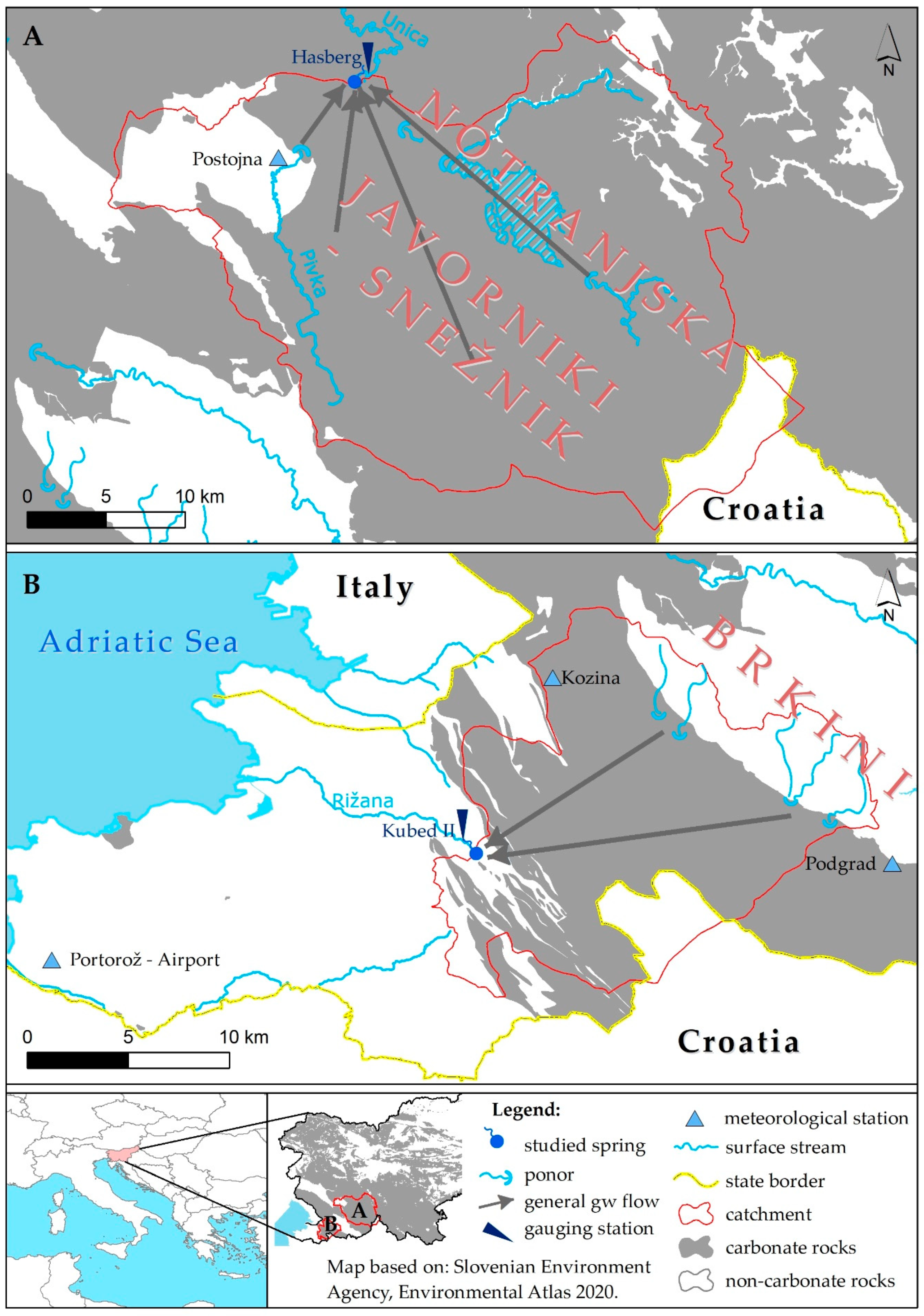


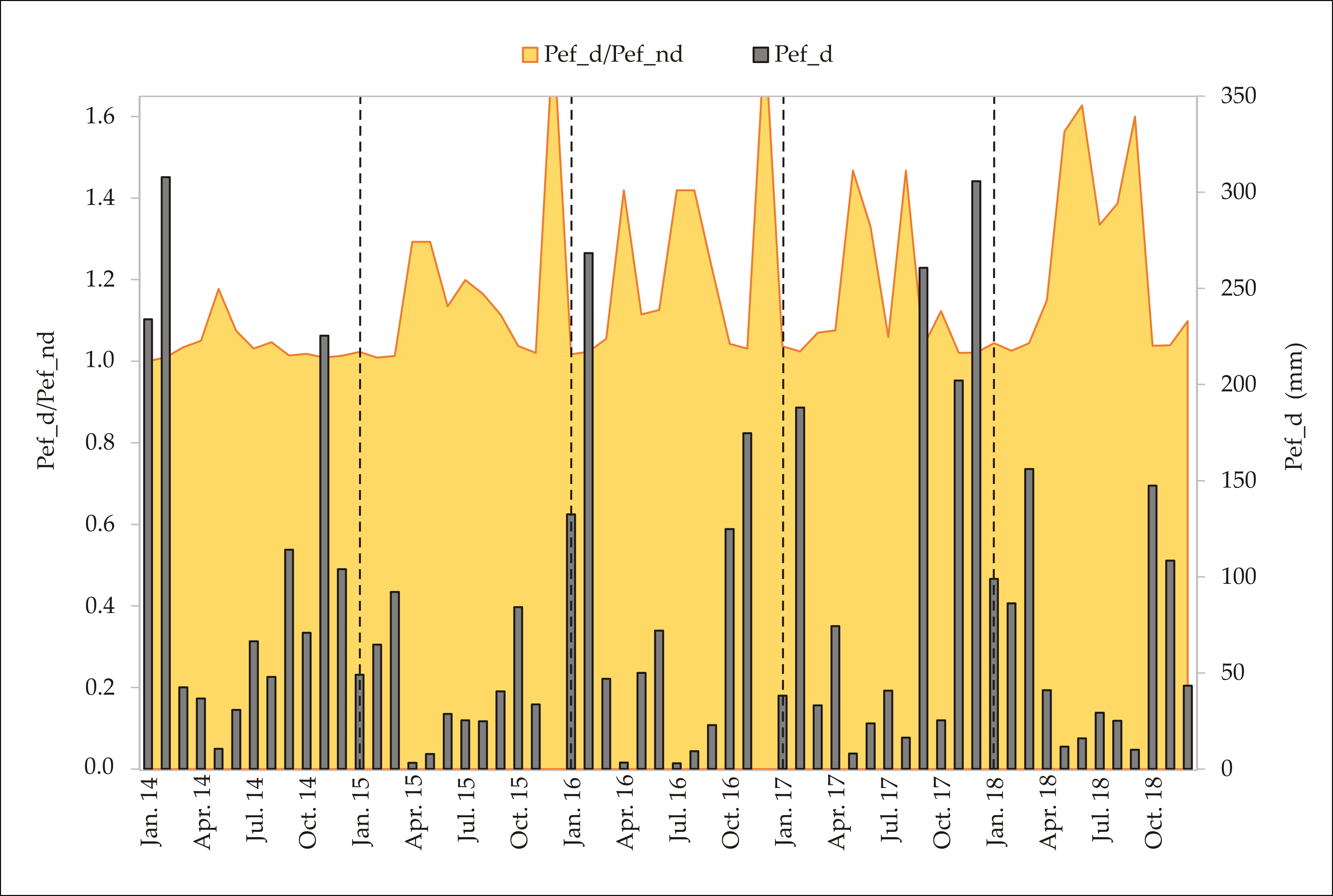
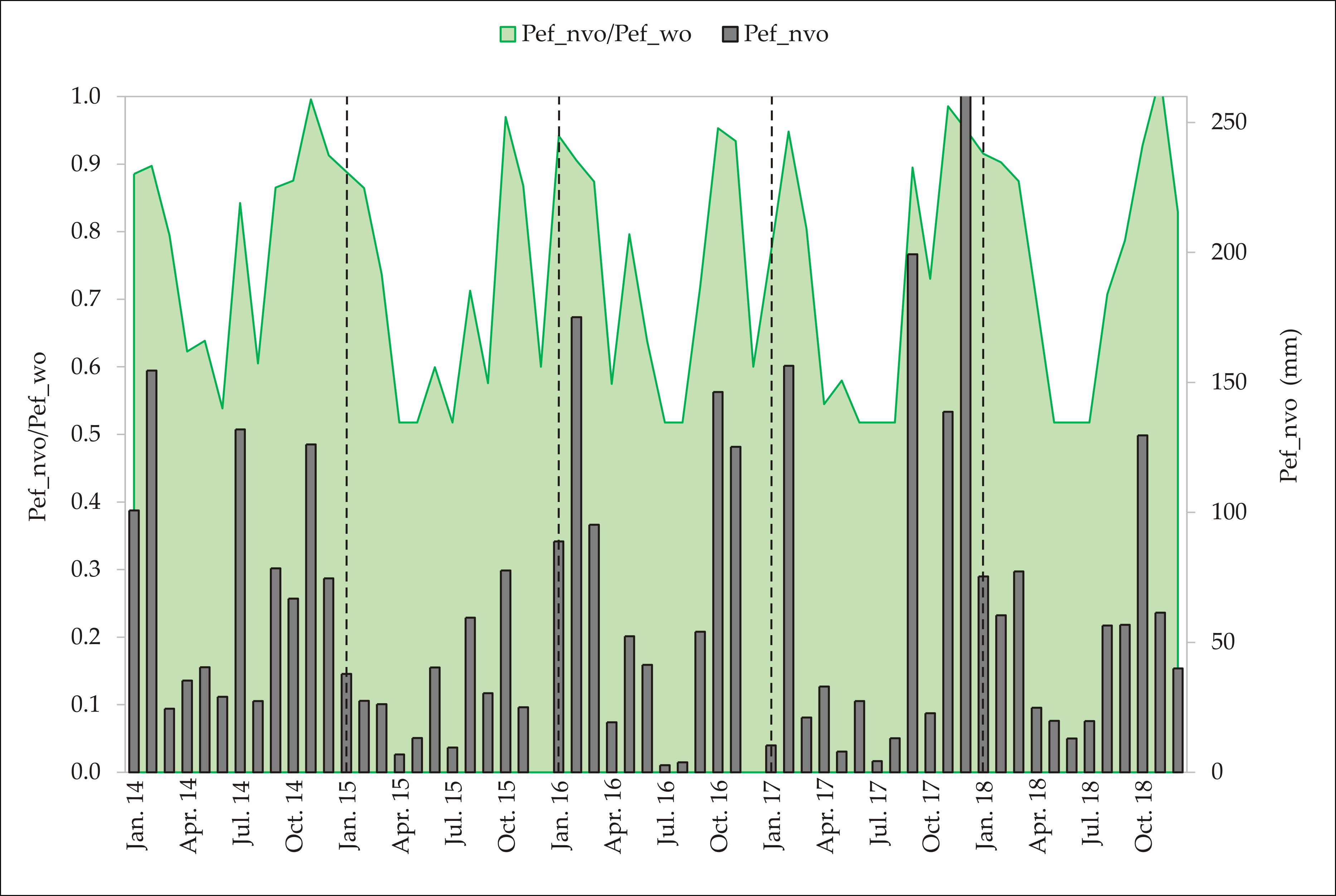
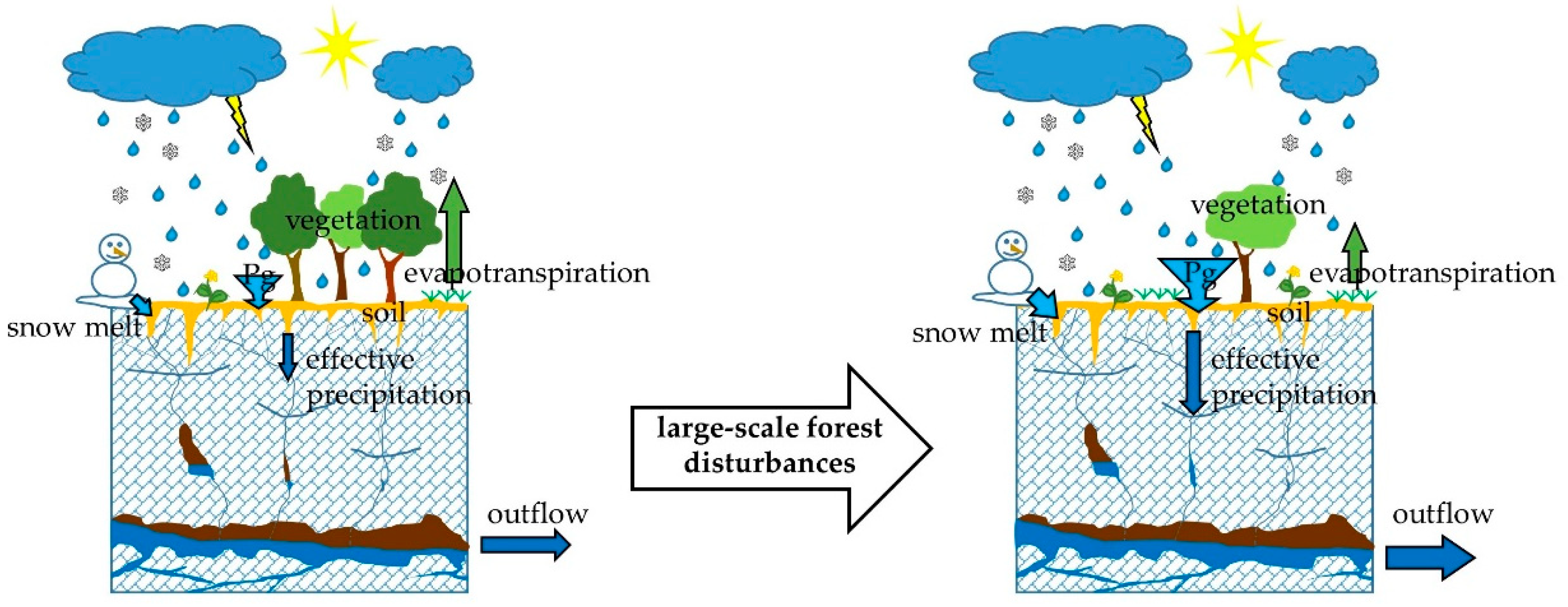
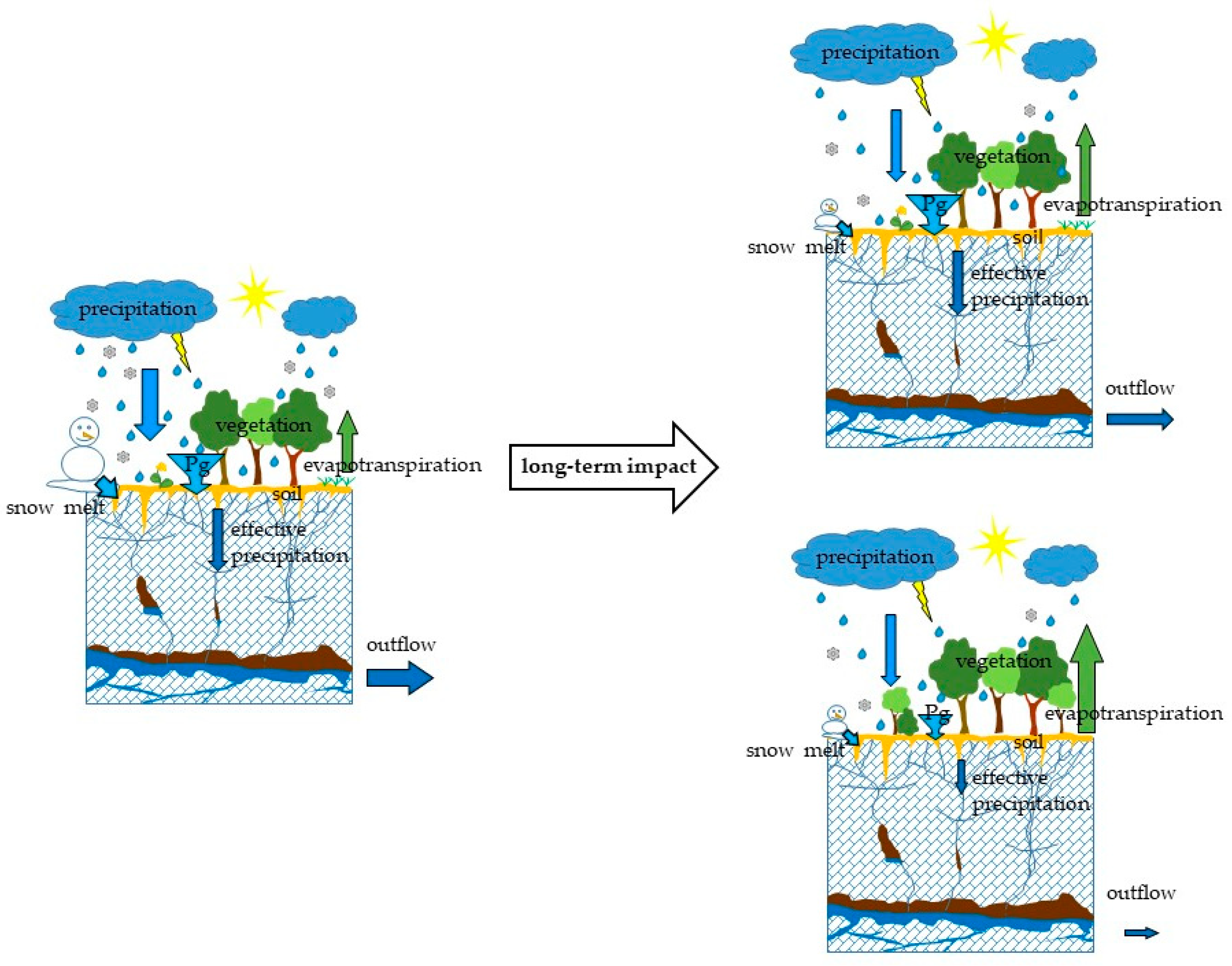
| The Unica Springs | The Rižana Spring | |
|---|---|---|
| Catchment size (km2) | >800 | ~250 |
| Catchment elevation range (m asl) | 450–1800 | 70–1100 |
| Discharge range (m3/s) | 1–90 | 0.07–63 |
| Mean discharge (m3/s) | 21 | 3.5 |
| Average annual precipitation (mm) | 1505 | 1484 |
| Average annual ETP (mm) | 738 | 892 |
| Average annual runoff (mm) | 767 | 592 |
| Average annual runoff ratio | 0.51 | 0.4 |
| Postojna (P) | Postojna (ETP) | Unica (Qmean) | Unica (Qmin) | Unica (Qmax) | Podgrad (P) | Podgrad (ETP) | Rižana (Qmean) | Rižana (Qmin) | Rižana (Qmax) | |
|---|---|---|---|---|---|---|---|---|---|---|
| Yearly | −2.841 * | 2.790 *** | −0.082 | −0.017 * | 0.011 | −3.960 | 3.512 *** | −0.038 *** | −0.003 *** | −0.275 * |
| January | −0.285 | 0.096 ** | 0.093 | −0.024 | 0.163 | −0.370 | 0.123 *** | −0.018 | −0.005 | −0.119 |
| February | 0.586 | 0.111 * | 0.035 | 0.010 | 0.137 | 0.282 | 0.123 * | −0.013 | −0.012 # | −0.017 |
| March | −0.522 | 0.304 *** | −0.040 | −0.019 | −0.002 | −0.419 | 0.260 ** | −0.013 | −0.009 | −0.097 |
| April | −0.942 # | 0.331 *** | −0.192 | −0.218 ** | −0.142 | −0.857 # | 0.277 *** | −0.057 ** | −0.012 * | −0.347 ** |
| May | −0.471 | 0.509 *** | −0.212 ** | −0.140 *** | −0.309 # | −0.181 | 0.419 ** | −0.037 * | −0.014 *** | −0.140 |
| June | −0.431 | 0.427 *** | −0.214 ** | −0.137 *** | −0.308 # | −0.373 | 0.512 *** | −0.034 * | −0.010 *** | −0.156 * |
| July | −0.698 | 0.468 *** | −0.127 *** | −0.049 *** | −0.268 ** | −0.477 | 0.585 *** | −0.011 ** | −0.005 *** | −0.027 |
| August | −0.914 | 0.467 *** | −0.078 ** | −0.029 ** | −0.189 * | −0.879 | 0.601 *** | −0.012 ** | −0.003 *** | −0.048 * |
| September | 0.296 | 0.055 | −0.093 | −0.031 * | −0.133 | 0.105 | 0.260 * | −0.028 * | −0.005 *** | −0.177 # |
| October | 0.825 | −0.008 | 0.016 | −0.017 | 0.224 | 0.787 | 0.184 | −0.004 | −0.004 # | 0.012 |
| November | −0.549 | 0.031 | 0.030 | 0.029 | −0.016 | −0.868 | 0.115 # | −0.035 | −0.001 | −0.241 # |
| December | −0.036 | 0.071 * | 0.022 | −0.038 | −0.062 | 0.070 | 0.137 ** | −0.036 | −0.005 | −0.294 # |
Publisher’s Note: MDPI stays neutral with regard to jurisdictional claims in published maps and institutional affiliations. |
© 2020 by the authors. Licensee MDPI, Basel, Switzerland. This article is an open access article distributed under the terms and conditions of the Creative Commons Attribution (CC BY) license (http://creativecommons.org/licenses/by/4.0/).
Share and Cite
Kovačič, G.; Petrič, M.; Ravbar, N. Evaluation and Quantification of the Effects of Climate and Vegetation Cover Change on Karst Water Sources: Case Studies of Two Springs in South-Western Slovenia. Water 2020, 12, 3087. https://doi.org/10.3390/w12113087
Kovačič G, Petrič M, Ravbar N. Evaluation and Quantification of the Effects of Climate and Vegetation Cover Change on Karst Water Sources: Case Studies of Two Springs in South-Western Slovenia. Water. 2020; 12(11):3087. https://doi.org/10.3390/w12113087
Chicago/Turabian StyleKovačič, Gregor, Metka Petrič, and Nataša Ravbar. 2020. "Evaluation and Quantification of the Effects of Climate and Vegetation Cover Change on Karst Water Sources: Case Studies of Two Springs in South-Western Slovenia" Water 12, no. 11: 3087. https://doi.org/10.3390/w12113087
APA StyleKovačič, G., Petrič, M., & Ravbar, N. (2020). Evaluation and Quantification of the Effects of Climate and Vegetation Cover Change on Karst Water Sources: Case Studies of Two Springs in South-Western Slovenia. Water, 12(11), 3087. https://doi.org/10.3390/w12113087





